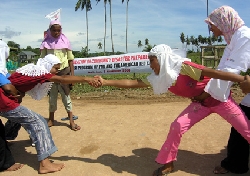
Contact: Michael Oko, American Red Cross, 202-303-6820; Spokespeople are available in tsunami-affected countries and
WASHINGTON, Dec. 19 /Standard Newswire/ -- Two years after the raging waters of the tsunami swept away lives, homes and communities in more than a dozen countries, daily routines are slowly coming back for those impacted by this disaster. However, for many people struggles persist. It is widely acknowledged that the greatest needs are for housing and livelihoods. In response, humanitarian agencies, including the American Red Cross, are collaborating to restore and rebuild houses and to provide new economic opportunities in affected communities. At the same time, the American Red Cross is working to ensure that critical emerging needs of survivors are being met.
Photo: Girls practice life-saving techniques. Disaster Preparedness exercises help prevent loss of life in future emergencies. (Credit: Holti Simanjuntak/American Red Cross)
"Over the past two years, there has been significant progress to assist survivors and to restore tsunami-affected communities," said David Meltzer, senior vice president of the International Services Department of the American Red Cross. "But we cannot forget the immediate needs of those in the affected areas. People need secure shelter, clean water and proper sanitation to be safe and healthy for today and for the future."
In
In
The American Red Cross is responding to livelihood needs through cash-for-work programs that provide short-term income for communities, while helping them to clean the environment. These programs have assisted nearly 14,500 people in
ADD ONE - TSUNAMI TWO YEAR LATER – AMERICAN RED CROSS
In its 125 years of responding to disaster, the American Red Cross has learned that as communities recover from a disaster, it is vital to be flexible in the response as new priorities often emerge. The American Red Cross works with partner Red Cross and Red Crescent national societies that have networks among the local communities to identify and respond to community needs.
"In order to maximize our positive impact on communities, it is essential that we engage and listen to the communities themselves," said Gerald Anderson, senior director of the Tsunami Recovery Program for the American Red Cross. "This is one of the most important aspects to ensure a successful, long term recovery."
Even though full recovery will take several more years, there has been substantial progress since December 2004. Through its programs, the American Red Cross has assisted more than three million people in nine tsunami-affected countries through its relief and recovery programs. In addition, the American Red Cross has reached more than 80 million through its disease prevention programs. Together with its partners, the American Red Cross is working vigorously to meet critical needs, while carrying-out long-term programs to support survivors and their communities on the road to recovery.
For more information regarding the American Red Cross Tsunami Recovery Program, see: www.redcross.org/tsunami.




 Sign Up to Receive Press Releases:
Sign Up to Receive Press Releases: